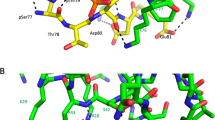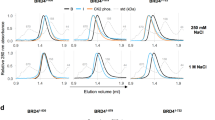Abstract
The BRCT repeats in BRCA1 are essential for its tumor suppressor activity and interact with phosphorylated protein targets containing the sequence pSer-X-X-Phe, where X indicates any residue. The structure of the tandem BRCA1 BRCT repeats bound to an optimized phosphopeptide reveals that the N-terminal repeat harbors a conserved BRCT phosphoserine-binding pocket, while the interface between the repeats forms a hydrophobic groove that recognizes the phenylalanine. Crystallographic and biochemical data suggest that the structural integrity of both binding sites is essential for peptide recognition. The diminished peptide-binding capacity observed for cancer-associated BRCA1-BRCT variants may explain the enhanced cancer risks associated with these mutations.
This is a preview of subscription content, access via your institution
Access options
Subscribe to this journal
Receive 12 print issues and online access
$189.00 per year
only $15.75 per issue
Buy this article
- Purchase on Springer Link
- Instant access to full article PDF
Prices may be subject to local taxes which are calculated during checkout





Similar content being viewed by others
References
Nathanson, K.L., Wooster, R., Weber, B.L. & Nathanson, K.N. Breast cancer genetics: what we know and what we need. Nat. Med. 7, 552–556 (2001).
Scully, R. et al. Genetic analysis of BRCA1 function in a defined tumor cell line. Mol. Cell 4, 1093–1099 (1999).
Venkitaraman, A.R. Cancer susceptibility and the functions of BRCA1 and BRCA2. Cell 108, 171–182 (2002).
Cantor, S.B. et al. Bach1, a novel helicase-like protein, interacts directly with brca1 and contributes to its DNA repair function. Cell 105, 149–160 (2001).
Bork, P. et al. A superfamily of conserved domains in DNA damage-responsive cell cycle checkpoint proteins. FASEB J. 11, 68–76 (1997).
Koonin, E.V., Altschul, S.F. & Bork, P. BRCA1 protein products ... Functional motifs... Nat. Genet. 13, 266–268 (1996).
Callebaut, I. & Mornon, J.P. From BRCA1 to RAP1: a widespread BRCT module closely associated with DNA repair. FEBS Lett. 400, 25–30 (1997).
Zhang, X. et al. Structure of an XRCC1 BRCT domain: a new protein-protein interaction module. EMBO J. 17, 6404–6511 (1998).
Huyton, T., Bates, P.A., Zhang, X., Sternberg, M.J. & Freemont, P.S. The BRCA1 C-terminal domain: structure and function. Mutat. Res. 460, 319–332 (2000).
Williams, R.S., Green, R. & Glover, J.N. Crystal structure of the BRCT repeat region from the breast cancer–associated protein BRCA1. Nat. Struct. Biol. 8, 838–842 (2001).
Joo, W.S. et al. Structure of the 53BP1 BRCT region bound to p53 and its comparison to the Brca1 BRCT structure. Genes Dev. 16, 583–593 (2002).
Krishnan, V.V., Thornton, K.H., Thelen, M.P. & Cosman, M. Solution structure and backbone dynamics of the human DNA ligase IIIα BRCT domain. Biochemistry 40, 13158–13166 (2001).
Derbyshire, D.J. et al. Crystal structure of human 53BP1 BRCT domains bound to p53 tumour suppressor. EMBO J. 21, 3863–3872 (2002).
Williams, R.S. & Glover, J.N. Structural consequences of a cancer-causing BRCA1-BRCT missense mutation. J. Biol. Chem. 278, 2630–2635 (2003).
Williams, R.S. et al. Detection of protein folding defects caused by BRCA1-BRCT truncation and missense mutations. J. Biol. Chem. 278, 53007–53016 (2003).
Rodriguez, M., Yu, X., Chen, J. & Songyang, Z. Phosphopeptide binding specificities of BRCA1 COOH-terminal (BRCT) domains. J. Biol. Chem. 278, 52914–52918 (2003).
Yu, X., Chini, C.C., He, M., Mer, G. & Chen, J. The BRCT domain is a phospho-protein binding domain. Science 302, 639–642 (2003).
Manke, I.A., Lowery, D.M., Nguyen, A. & Yaffe, M.B. BRCT repeats as phosphopeptide-binding modules involved in protein targeting. Science 302, 636–639 (2003).
Yaffe, M.B. & Smerdon, S.J. Phosphoserine/threonine binding domains: you can't pSERious? Structure 9, R33–R38 (2001).
Ekblad, C.M. et al. Characterisation of the BRCT domains of the breast cancer susceptibility gene product BRCA1. J. Mol. Biol. 320, 431–442 (2002).
Deffenbaugh, A.M., Frank, T.S., Hoffman, M., Cannon-Albright, L. & Neuhausen, S.L. Characterization of common BRCA1 and BRCA2 variants. Genet. Test. 6, 119–121 (2002).
Vallon-Christersson, J. et al. Functional analysis of BRCA1 C-terminal missense mutations identified in breast and ovarian cancer families. Hum. Mol. Genet. 10, 353–360 (2001).
Yarden, R.I. & Brody, L.C. BRCA1 interacts with components of the histone deacetylase complex. Proc. Natl. Acad. Sci. USA 96, 4983–4988 (1999).
Yu, X., Wu, L.C., Bowcock, A.M., Aronheim, A. & Baer, R. The C-terminal (BRCT) domains of BRCA1 interact in vivo with CtIP, a protein implicated in the CtBP pathway of transcriptional repression. J. Biol. Chem. 273, 25388–25392 (1998).
Miki, Y. et al. A strong candidate for the breast and ovarian cancer susceptibility gene BRCA1. Science 266, 66–71 (1994).
Sibanda, B.L. et al. Crystal structure of an Xrcc4–DNA ligase IV complex. Nat. Struct. Biol. 8, 1015–1019 (2001).
Clapperton, J.A. et al. Structure and mechanism of BRCA1 BRCT domain recognition of phosphorylated BACH1 with implications for cancer. Nat. Struct. Mol. Biol. advance online publication, 9 May 2004 (doi:10.1038/nsmb775).
Otwinowski, Z. & Minor, W. Processing of X-ray diffraction data collected in oscillation mode. Methods Enzymol. 276, 307–325 (1997).
Vagin, A. & Teplyakov, A. MOLREP: an automated program for molecular replacement. J. Appl. Cryst. 30, 1022–1025 (1997).
Jones, T.A., Zou, J.Y., Cowan, S.W. & Kjeldgaard, M. Improved methods for binding protein models in electron density maps and the location of errors in these models. Acta. Crystallogr. A 47, 110–119 (1991).
Terwilliger, T.C. SOLVE and RESOLVE: automated structure solution and density modification. Methods Enzymol. 374, 22–37 (2003).
Winn, M.D., Isupov, M.N. & Murshudov, G.N. Use of TLS parameters to model anisotropic displacements in macromolecular refinement. Acta. Crystallogr. D 57, 122–133 (2001).
Laskowski, R.A., MacArthur, M.W. & Thornton, J.M. Validation of protein models derived from experiment. Curr. Opin. Struct. Biol. 8, 631–639 (1998).
Merritt, E.A. & Bacon, D.J. Raster3D: photorealistic molecular graphics. Methods Enzymol. 277, 505–524 (1997).
Esnouf, R.M. An extensively modified version of MolScript that includes greatly enhanced coloring capabilities. J. Mol. Graph. Model. 15, 112–113, 132–134 (1997).
Acknowledgements
We are grateful to J. Parrish, E. Bergmann, T. Moraes, J. Holton and the Berkeley Centre for Structural Biology staff for discussions and technical support during data collection. Data was collected on Advanced Light Source beamline 8.3.1 with funding from the Alberta Synchrotron Institute as part of a participating research team. We thank M. Yaffe and S. Smerdon for sharing unpublished data and the gift of biotinylated peptide libraries, and R. Boyko for help with BRCT sequence alignments. This work was supported by a grant from the Canadian Breast Cancer Research Alliance. J.N.M.G. is a Canada research chair in structural molecular biology.
Author information
Authors and Affiliations
Corresponding author
Ethics declarations
Competing interests
The authors declare no competing financial interests.
Supplementary information
Rights and permissions
About this article
Cite this article
Williams, R., Lee, M., Hau, D. et al. Structural basis of phosphopeptide recognition by the BRCT domain of BRCA1. Nat Struct Mol Biol 11, 519–525 (2004). https://doi.org/10.1038/nsmb776
Received:
Accepted:
Published:
Issue Date:
DOI: https://doi.org/10.1038/nsmb776
This article is cited by
-
Spectrum of BRCA1 interacting helicase 1 aberrations and potential prognostic and therapeutic implication: a pan cancer analysis
Scientific Reports (2023)
-
Structure/function studies of the NAD+-dependent DNA ligase from the poly-extremophile Deinococcus radiodurans reveal importance of the BRCT domain for DNA binding
Extremophiles (2023)
-
Fanconi anemia pathway as a prospective target for cancer intervention
Cell & Bioscience (2020)
-
Distinct associations of the Saccharomyces cerevisiae Rad9 protein link Mac1-regulated transcription to DNA repair
Current Genetics (2020)
-
The dynamic organization of fungal acetyl-CoA carboxylase
Nature Communications (2016)



